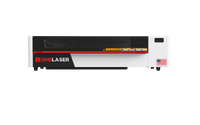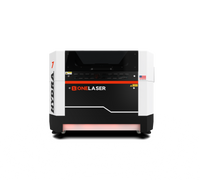If you’ve ever wasted material because your design didn’t land exactly where you expected, you already know why a laser engraver with camera is a game-changer. A built-in camera lets you see your workspace live, place artwork with pin-point accuracy, trace physical objects into vectors, and even monitor jobs remotely.
In short: fewer misalignments, faster setup, and cleaner deliveries—especially when you’re doing one-offs, short runs, or personalized orders.
Key Takeaway
This guide breaks down exactly what to look for in a laser engraving machine with camera, why camera quality matters, and how OneLaser’s X Series (XRF and XT) and Hydra Series turn camera tech into real-world productivity. We’ll cover accuracy, resolution, software compatibility, remote monitoring, and the workflow tricks pros use to reduce rework and increase profit.
1. Why a Laser Engraver Camera Matters
A well-implemented laser engraving camera does more than show you a grainy overhead photo. It becomes a precision tool across the entire job lifecycle:
- Live bed preview & drag-and-drop placement: See your actual material on screen and position designs exactly where you want them.
- Contour capture: Grab an outline of a physical object (e.g., a coaster, patch, or plaque) and fit your design to its shape.
- Registration alignment: Re-run jobs on partially finished pieces or multi-stage projects without eyeballing it.
- Batch layout speed: Place multiple items, nudge designs per piece, and start engraving faster.
- Pass-through accuracy: Keep long boards aligned across multiple camera frames.
- Remote monitoring: Check progress on your phone or computer so you can multitask confidently.
When the camera system is paired with strong motion control and autofocus, it becomes the backbone of a reliable, repeatable workflow—exactly what small businesses and growing shops need.

2. Quick Overview: OneLaser Models with Integrated 5M Camera
Both the OneLaser X Series (desktop) and Hydra Series (cabinet) feature a high-precision 5-megapixel camera designed for accurate contour grabbing, remote monitoring, and precise alignment:
2.1 OneLaser X Series (XRF & XT)
- Best fit: Small businesses, workshops, hobby-to-pro transitions, and detailed customization.
-
Laser types:
- XRF: 38W RF metal tube for ultra-fine detail, 0.07 mm spot, instant startup, longer life (up to ~30,000 hours; up to 2,000 DPI).
- XT: 55W CO₂ glass tube for stronger cutting power (0.25 mm spot).
- Speed: Up to 1200 mm/s (XRF), 1000 mm/s (XT).
- Accuracy: Positioning accuracy ≤ 0.01 mm.
- Work area: 23.6″ × 11.8″ desktop-friendly.
- Camera use cases: Tight product photography alignment, micro-placement for jewelry tags, patch positioning, and quick one-off personalization.
- Extras: XFocus™ autofocus, RedDot positioning, FumeGuard™, Wi-Fi control, built-in cooling, Base Boost™ riser for tall/rotary jobs, conveyor feeder add-on, and Smart Air Assist Control.
Discover the OneLaser X Series!

2.2 OneLaser Hydra Series (Hydra 7/9/13/16)
- Best fit: Industrial-grade, high-volume production, dual-laser performance.
- Laser types: Hybrid platform supports CO₂ glass (80–150W, depending on model) and optional RF metal tubes (38/75W) for precision engraving—switch between detailing and powerful cutting.
- Speed & motion: 1200 mm/s with true 3G acceleration (29,430 mm/s²).
- Accuracy: Positioning accuracy ≤ 0.01 mm; CO₂ dot ~0.25 mm, RF dot ~0.07 mm.
- Workspaces:
- Camera use cases: Large-format nesting, multi-piece alignment, on-the-fly QC/monitoring across big beds, pass-through positioning, and batch personalization.
- Extras: OneTouch+™ control, XFocus™ autofocus, adjustable airflow with built-in solenoid, QuickSwitch™ lenses, FumeGuard™, Wi-Fi, heavy-duty cooling, and fully enclosed safety.

Bottom line: If you want a compact, laser engraver with camera that’s easy to start and scale, the X Series is ideal. If you need industrial throughput with camera-assisted precision over a big field, the Hydra is your production workhorse.
3. Camera Specs That Actually Matter (And Why)
Lots of machines advertise a “camera,” but not all camera systems are equal. Here’s what to evaluate when you’re comparing a laser engraver camera system:
Resolution (e.g., 5M / 5 megapixels):
Higher resolution means more detailed previews for precise placement—critical when you’re aligning to small items, tight tolerances, or fine text. OneLaser’s 5M camera shines in this category.


Calibration & distortion handling:
The best systems apply lens calibration so the camera’s view matches bed coordinates. That means what you see on screen is what you engrave—no guessing.
Field of view & lighting:
Wide, evenly lit captures help on large beds and with darker materials. The Hydra’s panoramic visibility and large work area pair well with its camera for batch layouts.
Software integration:
Seamless compatibility with LightBurn / RDWorks enables live overlays, contour capture, and “click-to-place” workflows. OneLaser supports both, plus common design formats (AI, PDF, DXF, SVG, LBRN, PNG/JPG/TIFF, etc.).
Positional accuracy (machine-level):
Cameras are only as good as the motion system they instruct. With ≤ 0.01 mm positioning and advanced DSP motion control, OneLaser ensures the laser lands where the camera says it will.
Autofocus synergy:
XFocus™ (motorized autofocus) ensures camera-assisted placement is matched with correct Z-height for crisp results—especially important when you switch between materials or add jig fixtures.

Remote monitoring:
A camera that also streams for status checks is a real productivity boost—especially on long runs. OneLaser’s Wi-Fi connectivity and 5M camera make remote checks smooth.
Explore Our Laser Engravers & Cutters!
4. How to Set Up Camera for Laser Engraver
Here are some videos showing how to set up and troubleshoot laser engraver cameras:
5. Real Jobs Where a Camera Pays for Itself
- Personalization on pre-made goods: Engrave on cutting boards, notebooks, wallets, and awards with exact placement—no jig guesswork.
- Logo patches & hat clips: Align logos within pre-cut blanks quickly (Hydra users love this for high-volume apparel accessories).
- Small jewelry & tags: With 0.07 mm RF spot on XRF and camera alignment, micro-detail becomes routine.
- Photo engravings: Ensure face placement and cropping land exactly within frames or blanks.
- Pass-through signs: Keep long boards straight and continue designs across camera frames.

6. Camera + Autofocus + Motion Control: Why This Trio Wins
A laser engraver with camera is only as dependable as its focusing and motion stack. OneLaser’s edge comes from:
- XFocus™ motorized autofocus (camera placement meets perfect focal distance).
- ≤ 0.01 mm positioning plus advanced DSP motion control (smooth, repeatable, and fast).
- RF metal tube options for ultra-tight spot sizes (0.07 mm) and crisp, high-DPI engraving.
- Fume management (FumeGuard™) and Smart Air Assist for cleaner marks that photograph well and ship clean.
Together, these features mean camera placement doesn’t just look right on screen—it engraves exactly right on the workpiece.
7. X Series vs. Hydra for Camera-Driven Workflows
Pick the X Series if you:
- Want desktop convenience with true professional accuracy.
- Do a lot of personalization and small-format products.
- Need RF precision (XRF) or great cutting power on a budget (XT).
- Value low noise, built-in cooling, and one-plug simplicity.
Pick the Hydra if you:
- Need industrial throughput and bigger beds.
- Want dual-laser flexibility (RF detail + CO₂ cutting).
- Run long shifts or 24/7 with advanced airflow and cooling.
- Require camera accuracy at scale for batch layouts.
Either path gives you a laser engraver with camera that’s designed for real shops, not just spec sheets.
8. Pro Tips to Get the Most from Your Laser Engraving Camera
- Use jigs—but rely on the camera for micro-adjustments. Jigs speed repeatability; the camera perfects alignment for natural materials (think driftwood, slate, leather).
- Set material presets in LightBurn. Camera time savings multiply when your power/speed settings are ready to go.
- Tune air assist per job. Low flow for engraving (keeps soot from blowing into fresh marks); high flow for cutting (clean edges).
- Leverage pass-through with the camera. Mark a reference line in software and advance boards to the same index each time.
- Validate with RedDot. When in doubt, run the “laser off” preview so you never sacrifice a blank.
9. FAQs
Q: Is a laser engraver with camera worth it for beginners?
A: Absolutely. The live preview removes guesswork, reduces scrap, and speeds learning. It’s one of the most helpful features you can buy early.
Q: Can I add a camera to a machine later?
A: Aftermarket cameras exist, but native systems (like OneLaser’s 5M camera) are factory-tuned to the frame, optics, and motion control—yielding more reliable accuracy.
Q: Does the camera improve engraving quality?
A: Indirectly. The camera improves placement and workflow efficiency. Engraving quality comes from tube type (RF vs. glass), spot size, speed/acceleration, optics, and airflow. OneLaser’s RF option (XRF/Hydra) excels for fine detail.
Q: How accurate is camera placement?
A: With proper calibration and a machine that holds ≤ 0.01 mm accuracy (like OneLaser), what you place on screen is what you engrave.
Q: Do I need autofocus if I have a camera?
A: Yes. The camera aligns placement; autofocus (XFocus™) ensures the beam is perfectly focused for consistent depth and crispness.
Have Questions? Join Our Forum!
Final Thoughts
A laser engraver with camera should do more than “look cool” on a brochure. It should reduce waste, speed setups, align complex parts, and let you monitor jobs from anywhere. That’s exactly what OneLaser builds around its 5M camera—and why it pairs that vision system with pro-grade motion control, autofocus, fume safety, smart airflow, and Wi-Fi.
- Choose the OneLaser XRF (38W RF) if you want the finest engraving precision in a compact, quiet desktop package.
- Choose the OneLaser XT (55W CO₂) if you need thicker-material cutting with an affordable entry point—still with camera accuracy.
- Choose the Hydra Series if you need industrial bed sizes, dual-laser flexibility, and camera-driven batch throughput at 1200 mm/s with true 3G acceleration.
Whichever you pick, you’ll feel the difference the first time you place artwork over a live camera preview and the engraving lands exactly—perfectly—where you planned.

 Liquid error (sections/image-banner line 171): invalid url input
Liquid error (sections/image-banner line 171): invalid url input






